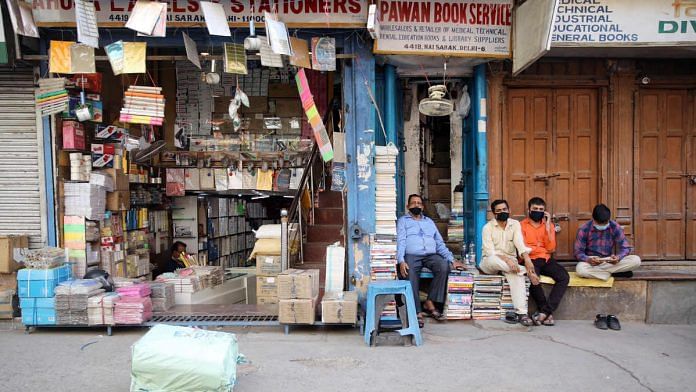New Delhi: A partial lifting of the lockdown in May saw 2.1 crore more people getting employed than in April, when most economic activity remained suspended due to Covid-19.
More than two-thirds of the jobs added in May were of small traders and wage labourers, the segments hit hardest by the lockdown.
According to data released by the Centre for Monitoring Indian Economy (CMIE), 30 crore people were employed in May, as against 28 crore in April and 39.6 crore in March. Consequently, the employment rate also improved to 29.2 per cent from 27.2 per cent in April. In 2019-20, the average number of employed people was over 40 crore.
The unemployment rate in May was nearly unchanged at 23.5 per cent. This is because the labour force participation rate, or the number of people actively looking for jobs, increased in May as compared to April. The labour participation rate increased to 38.2 per cent from 35.6 per cent in April.
Also read: How many jobs have we lost during lockdown? PMO seeks answers from ministries
Actively looking for jobs
Prime Minister Narendra Modi’s 24 March announcement of a nationwide lockdown beginning within hours saw many industries abruptly halting production, leading to a loss of jobs.
Halt in most services and trading activity and construction also contributed to job losses, forcing many migrant workers to return to their villages on foot. But economic activity has started gradually, resuming in many states that were less impacted by Covid-19.
“A number of people who had left the active labour markets in April returned in May. People who had left the labour market in April because of large-scale job losses had parked themselves in the passive unemployed category. They declared themselves as unemployed and willing to work but not actively looking for jobs. In May, many of these were back, actively looking for jobs,” Mahesh Vyas, managing director and chief executive of CMIE, said in a note.
Vyas pointed out that the unemployment rate fell to 20.2 per cent in the last week of May, the lowest level since the imposition of the lockdown.
This data will come as a ray of hope to policy makers, and is indicative of an improvement in the unemployment situation in the coming months, with the central government permitting many economic activities beginning June.
Vyas said labour statistics may show further improvement as the lockdown is lifted in phases, but pointed out that most of the initial improvements will be in “poor quality jobs”.
Decline in salaried jobs
CMIE data showed that while jobs of business persons and those working in the farm sector grew in May over April, salaried jobs declined marginally.
“Salaried jobs are relatively difficult to get, and salaried jobs lost during a lockdown are far more difficult to recover. These are also the better jobs. The continued loss of good quality jobs is, therefore, worrisome,” Vyas said.
The age distribution of the jobs added in May shows that while employment increased in all age groups, it decreased marginally in the 25-29-year-old age group.
“The increase in jobs in May 2020 reflects a partial lifting of the lockdown. Such a partial lifting could have generated only those informal jobs of the self-employed that are in the unorganised sectors. It could not have generated jobs for the 25-29-year-olds who principally seek better quality jobs. It could not have created jobs for salaried employees either,” Vyas wrote.
“Salaried jobs will increase in a meaningful sense only when investments increase. This is a distant dream.”
Also read: Unemployment in March highest since September 2016, CMIE data shows fallout of Covid-19



